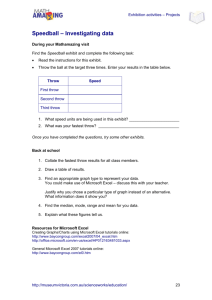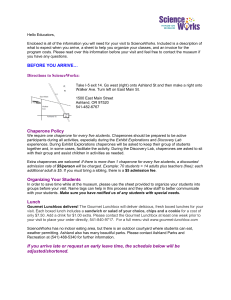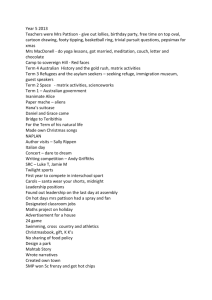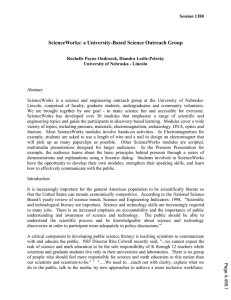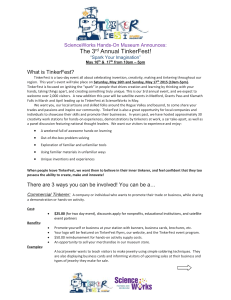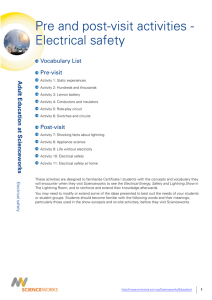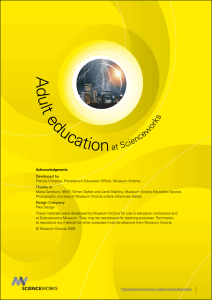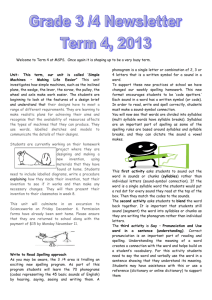Activities for adult students at Scienceworks
advertisement
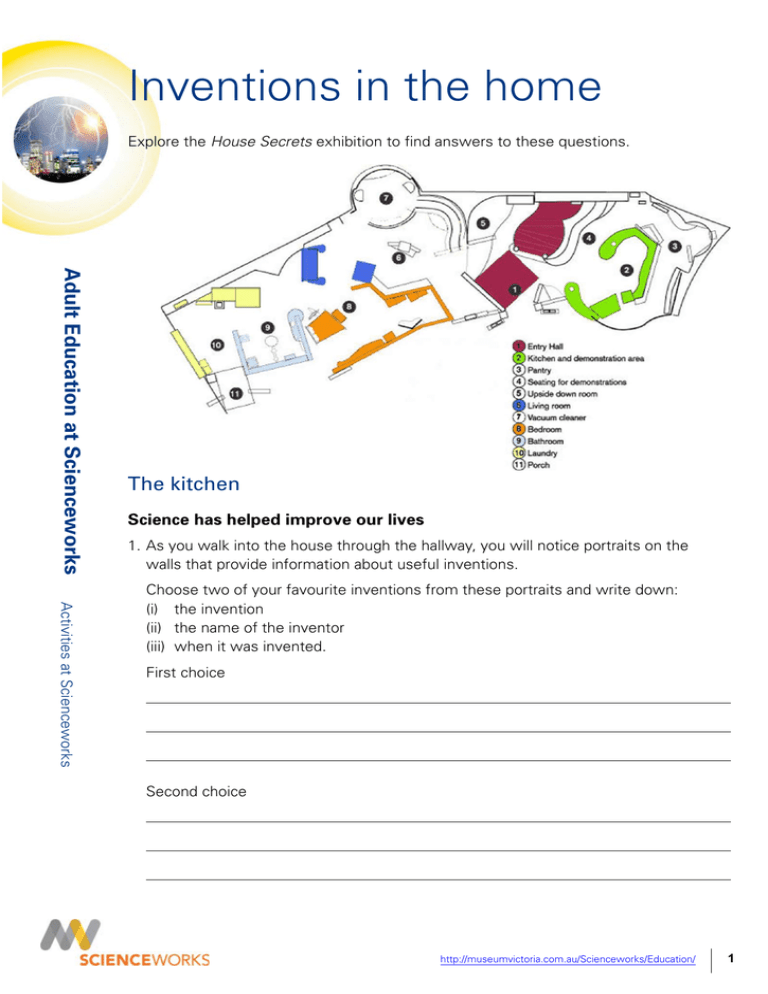
Inventions in the home Explore the House Secrets exhibition to find answers to these questions. Adult Education at Scienceworks The kitchen Science has helped improve our lives 1.As you walk into the house through the hallway, you will notice portraits on the walls that provide information about useful inventions. Activities at Scienceworks Choose two of your favourite inventions from these portraits and write down: (i) the invention (ii) the name of the inventor (iii) when it was invented. First choice Second choice http://museumvictoria.com.au/Scienceworks/Education/ 1 2.Find the wall with the display of kitchen utensils that are simple machines. Simple machines help make our work easier. From this display write down an example of a: a) Lever b)Wedge c) Set of gears d)Wheel and axle Adult Education at Scienceworks 3.Find the Husqvarna microwave that was used in 1960. Look at the more modern microwave on the top shelf. What changes in technology do you think influenced the more recent design? 4.Science can improve the way we cook and store food, helping to prevent the spread of disease. a) What are some ways we should cook food so that we do not become sick? b) What are some ways that we should store food so that we do not become sick? Activities at Scienceworks The living room Science and communication 1.Select two examples of communication devices that you see in this area. 2.What improvements have been made to these devices over time? 3.What effects do these have on our lives? http://museumvictoria.com.au/Scienceworks/Education/ 2 The bathroom Science and hygiene 1.Look around the bathroom and write down examples of how science has improved hygiene? Adult Education at Scienceworks 2.Showers keep us clean but use a lot of water. Find our how much water you can save if you take shorter showers. The porch Science and conservation 1.Walk behind the wall of the bathroom and find the different types of insulation. 2.Place your hand underneath to feel the temperature in the boxes with the different types of insulation. a) Which one is most effective? b)Which one is least effective? c) Why do we need insulation in our homes? Activities at Scienceworks d)Have you seen anything else in the House Secrets exhibition that helps to conserve energy? If so, what did you find? http://museumvictoria.com.au/Scienceworks/Education/ 3 Energy transformations Explore the House Secrets exhibition to find answers for these questions. Adult Education at Scienceworks The living room Find the wave making machine called ‘CRANK THE HANDLE’ 1.What happens to the wave when you crank the handle faster and put in more energy? Activities at Scienceworks 2.What happens to the wave when you crank the handle slower and put in less energy? 3.What does this tell you about the energy of waves that have a shorter wavelength compared to those that have a longer wavelength? http://museumvictoria.com.au/Scienceworks/Education/ 4 Find the machine called ‘LOUD AND CLEAR’ close by. Press the yellow button and watch what happens to the sound wave represented on the screen. 1.What generally happens to the sound waves when the pitch of the voice is low? 2.What generally happens to the sound waves when the pitch of the voice is high? Adult Education at Scienceworks 3.What generally happens to the sound waves when the sound of the voice is loud? The kitchen Find the appliances case behind the kitchen. 1.Write down the name of three electrical appliances that convert electrical energy to heat energy. 2.Describe how one of these works. Activities at Scienceworks 3.Write down the name of two electrical appliances that convert electrical energy to movement energy. 4.Describe how one of these works. Find the refrigerator. Read the panel and find out how it works. Have a go. 1.Explain how it works in your own words. 2.What energy transformations are taking place? http://museumvictoria.com.au/Scienceworks/Education/ 5 Earth, Sun and seasons At the Melbourne Planetarium, you will see the Spinning Out show and a brief introduction to the stars in the evening sky this month. Get into groups of three after watching the show. Together, try to recall the answers to the following questions. Question 1 Why do we have seasons on Earth? Adult Education at Scienceworks Question 2 What is the longest day of the year called? Question 3 What is the shortest day of the year called? Question 4 Activities at Scienceworks What are the days that we have equal day and night in a year called? http://museumvictoria.com.au/Scienceworks/Education/ 6 Navigating by the stars At the Melbourne Planetarium, you will see the Guiding Lights show and a brief introduction to the stars in the evening sky this month. Get into groups of three after watching the show. Together, try to recall the answers to the following questions. Question 1 Name at least two instruments that were once used to measure latitude at sea. Adult Education at Scienceworks Question 2 John Harrison won a prize for his design of a highly accurate clock called a chronometer. The chronometer was able to accurately tell the time in a place in England called Greenwich. What was so important about this discovery? Question 3 (for Certificate II students) Activities at Scienceworks Two hundred years after the discovery of the chronometer, what navigational system was introduced that was responsible for the greatest revolution in earthbound navigation? http://museumvictoria.com.au/Scienceworks/Education/ 7 Electrical safety The Lightning Room is a purpose-built high voltage theatre which features unique laboratory equipment. You will see the Electrical Energy, Safety and Lightning Show which demonstrates electricity generation, use and safety. Medical condition caution Please inform your students that some equipment used in The Lightning Room generates sudden loud noises during the shows. People with hearing problems or hearing-aids may be affected. The presenter will warn the audience before loud noises. Adult Education at Scienceworks During and/or after the show, answer the following questions. 1.A Van de Graaff Generator is a machine designed to build up charge. Explain how it works and why the volunteer’s hair was standing up on end? Why was the volunteer safe from getting an electric shock? 2.What materials (demonstrated) conducted electricity? 3.What materials didn’t conduct electricity? Activities at Scienceworks 4.What can you do to decrease your chances of getting struck by lightning? http://museumvictoria.com.au/Scienceworks/Education/ 8 Electricity, magnets & motors The Lightning Room is a purpose-built high voltage theatre which features unique laboratory equipment. You will see the Electricity, Magnets and Movement Show which explores the relationships between electricity, magnetism and movement and how these can affect our lives. Medical condition caution Adult Education at Scienceworks Please inform your students that some equipment used in The Lightning Room generates sudden loud noises during the shows. People with hearing problems or hearing-aids may be affected. The presenter will warn the audience before loud noises. During and/or after the show, answer the following questions. 1.Which devices work just like an electric generator? 2.Which devices work just like a motor? Activities at Scienceworks 3.What can you do to decrease your chances of getting struck by lightning if you are outdoors and a storm is approaching? http://museumvictoria.com.au/Scienceworks/Education/ 9 Optional: Go to the House Secrets Exhibition 1.Find and name 3 appliances or machines that use electricity but in the past used no electricity. 2.For each appliance, write what type of energy conversions taking place when the appliance is in use. Adult Education at Scienceworks 3.Find and name three appliances or machines used in the home that use motors. 4.Which exhibit in the House Secrets exhibition uses human energy (chemical energy) to generate electricity? a) Draw a flowchart of the energy conversions taking place in this exhibit. Activities at Scienceworks b)Given what you know about how electricity is generated, explain how this exhibit works. http://museumvictoria.com.au/Scienceworks/Education/ 10
